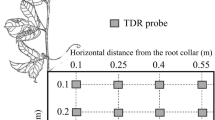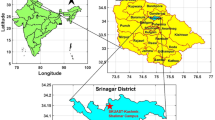Abstract
A drip-irrigation module was developed and included in an ecosystem model and tested on two independent datasets, spring and autumn, on field-grown tomato. Simulated soil evaporation correlated well with measurements for spring (2.62 mm d−1 compared to 2.60 mm d−1). Changes in soil water content were less well portrayed by the model (spring r 2 = 0.27; autumn r 2 = 0.45). More independent data is needed for further model testing in combination with developments of the spatial representation of below-ground variables. In a fresh-water drip-irrigated system, about 30% of the incoming water was transpired, 40% was lost as non-productive evaporative flows, and the remainder left the system as surface runoff or drainage. Simulations showed that saline water irrigation (6 dS m−1) caused reduced transpiration, which led to higher drainage and soil evaporation, compared with fresh water. Covering the soil with plastic mulch resulted in an increase in yield and transpiration. Finally, two different drip-irrigation discharge rates (0.2 and 2.5 l h−1) were compared; however the simulations indicated that the discharge rate did not have any impact on the partitioning of the incoming water to the system. The model proved to be a useful tool for evaluating the importance of specific management options.








Similar content being viewed by others
Notes
If the fraction of the uncovered soil is larger than the wetted area, soil evaporation will also take place from the area that was not affected by irrigation. However, that was not the case in this study.
References
Al-Jamal MS, Ball S, Sammis TW (2001) Comparison of sprinkler, trickle and furrow irrigation efficiencies for onion production. Agric Water Manage 46:253–266
Alvenäs G, Jansson P-E (1997) Model for evaporation, moisture and temperature of bare soil: calibration and sensitivity analysis. Agric For Meteorol 88:47–56
Chitsiko RJ, Mudima KT (2002) Adapting modern irrigation technologies for use by smallholder farmers—the Zimbabwean experience. Paper presented at the seminar: “Smallholder Land and Water Management Systems—Sharing Lessons from Experiences in Africa and Asia”, 1–5 July 2002, Bangkok, Thailand. 11 pp
Collatz GJ, Ball JT, Grivet C, Berry JA (1991) Physiological and environmental regulation of stomatal conductance, photosynthesis and transpiration: a model that includes a laminar boundary layer. Agric For Meteorol 54:107–136
Daamen CC, Simmonds LP, Wallace JS, Laryea KB, Sivakumar MVK (1993) Use of microlysimeters to measure evaporation from sandy soils. Agric For Meteorol 65:159–173
Dasberg S, Or D (1999) Drip irrigation. Springer, Berlin Heidelberg Newyork, p 162
Du Plessis FJ, Van der Stoep I (2000) Evaluation of the appropriateness and management requirements of micro-irrigation in small-scale farming. In: 6th International micro-irrigation congress, “Micro-irrigation Technology for Developing Agriculture”, conference papers, South Africa, 11 pp
Falkenmark M, Rockström J (2004) Balancing water for humans and nature: the new approach in ecohydrology. EarthScan, London, p 247
Farquhar GD, von Caemmerer S, Berry JA (1980) A biochemical model of photosynthetic CO2 assimilation in leaves of C3 species. Planta 149:78–90
Hoffman GJ, Rhoades JD, Letey J, Sheng F (1990) Salinity management. In: Hoffman GJ, Howell TA, Solomon KH (eds) Management of farm irrigation systems. ASAE Monograph, USA, pp 667–715
Jansson P-E, Halldin S (1979) Model for the annual water and energy flow in a layered soil. In: Halldin S (ed) Comparison of forest and energy exchange models. Society for Ecological Modelling, Copenhagen, pp 145–163
Jansson P-E, Karlberg L (2004) Coupled heat and mass transfer model for soil-plant-atmosphere systems. Royal Institute of Technology, Dept. of Land and Water Resources Engineering, Stockholm, Sweden, TRITA-LWR report 3087, 427 pp
Kabutha C, Blank H, van Koppen B (2000) Drip irrigation kits for small-holder farmers in Kenya: experience and a way forward. In: 6th International micro-irrigation congress, “Micro-irrigation Technology for Developing Agriculture”, conference papers, South Africa, 7 pp
Karlberg L, Penning de Vries FWT (2004) Exploring potentials and constraints of low-cost drip irrigation with saline water in sub-Saharan Africa. Phys Chem Earth 29:1035–1042
Karlberg L, Ben-Gal A, Jansson P-E, Shani U (2006a) Modelling transpiration and growth in salinity-stressed tomato under different climatic conditions. Ecol Modell 190:15–40
Karlberg L, Rockström J, Annandale JG, Steyn JM (2006b) Low-cost drip irrigation of tomatoes using saline water: a suitable technology for southern Africa? Agric Water Manage (in press)
Li J, Zhang J, Rao M (2004) Wetting patterns and nitrogen distributions as affected by fertigation strategies from a surface point source. Agric Water Manage 67:89–104
Meiri A, Frenkel H, Mantell A (1992) Cotton response to water and salinity under sprinkler and drip irrigation. Agron J 84:44–50
Monteith JL (1965) Evaporation and environment. In: Fogg GE (ed) The state and movement of water, in living organisms. 19th symposium of the society of experimental biology. The Company of Biologists, Cambridge, pp 205–234
Rhoades JD, Kandiah A, Mashali AM (1992) The use of saline waters for crop production. FAO irrigation and drainage paper, FAO, United Nations, Rome, 48 pp
Richards LA (1931) Capillary conduction of liquids in porous media. Physics 1:318–333
Suarez D (1992) Perspective on irrigation management and salinity. Outlook Agric 21(4):287–291
Tesfamariam E (2004) Modelling the soil water balance of canola (Brassica napus L. cv. Hyola 60). M.Sc. Agric. Dissertation, University of Pretoria, South Africa
van Genuchten MTh (1983) Analyzing crop salt tolerance data: model description and user’s manual. Research Report No.120, United States Department of Agriculture, Agricultural Research Service, U.S. Salinity Laboratory, Riverside, 49 pp
van Genuchten MTh, Hoffman GJ (1984) Analysis of crop salt tolerance data. Ecol Stud Anal Synth 51:258–271
Acknowledgments
This study was funded by the Swedish International Development Cooperation Agency, Sida. We are grateful to Duncan McConnachie for correcting the language.
Author information
Authors and Affiliations
Corresponding author
Additional information
Communicated by P. Waller.
Rights and permissions
About this article
Cite this article
Karlberg, L., Jansson, PE. & Gustafsson, D. Model-based evaluation of low-cost drip-irrigation systems and management strategies using saline water. Irrig Sci 25, 387–399 (2007). https://doi.org/10.1007/s00271-006-0054-8
Received:
Accepted:
Published:
Issue Date:
DOI: https://doi.org/10.1007/s00271-006-0054-8




